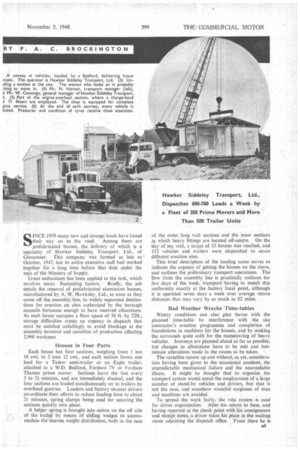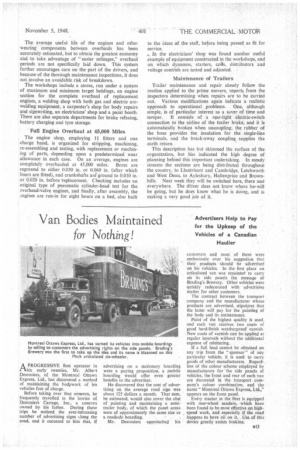HOUSES BYROAD FOR THE MASSES
Page 42

Page 43

Page 44

Page 47

If you've noticed an error in this article please click here to report it so we can fix it.
SINCE 1939 many new and strange loads have found their way on to the road. Among them are prefabricated houses, the delivery of which is a 'speciality of Hawker Siddeley Transport. Ltd., of Gloucester. This company was formed as late as October. 1947, but its entire executive staff had worked together for a long time before that date under the
gis of the Ministry of Supply.
Great enthusiasm has been applied to the task, which involves many fluctuating factors. Briefly, the job entails the removal of prefabricated aluminium houses, manufactured by A. W. Hawksley, Ltd., as soon as they come off the assembly line, to widely separated destinations for erection on sites authorized by the borough councils fortunate enough to have received allocations. As each house occupies a floor space of 30 ft. by 22ft., storage difficulties create an urgency in dispatch that must be satisfied unfailingly to avoid blockage at the assembly terminal and cessation of production affecting 2,900 workmen Houses in Four Parts Each house has four sections, weighing from l ton 18 cwt. to 2 tons 12 cwt., and each section forms one load for a Tasker semi-trailer or an Eagle trailer, attached to a W.D. Bedford, Fordson 7V or Fordson Thames prime mover. Sections leave the line every 3 to 31, minutes, and are immediately sheeted, and the four sections are loaded simultaneously on to trailers by overhead gantries. Loaders and factory shunter drivers co-ordinate their efforts to reduce loading time to about 2iminutes, spring clamps being used for securing the sections quickly into place.
•• A helper spring is brought into action on the off side of the trailer by means of sliding wedges to accommodate the 'uneven weight distribution, both in the ease of the outer long wall sections and the inner sections in which heavy fittings are located off-centre. On the day of my visit, a target of 33 houses was reached, and 132 vehicles and trailers were dispatched to seven different erection sites.
This brief description of the loading scene serves to indicate the urgency of getting the houses on the move, and outlines the preliminary transport operations. The flow from the assembly line is practically uniform for five days of the week, transport having to match this uniformity exactly at the factory focal point, although it is operated seven days a week over average return distances that may vary by as much as 82 miles.
Bad Weather Wrecks Time-tables Wintry conditions can also play havoc with the planned time-table by interference with the site contractor's erection programme and completion of foundations in readiness for the houses, and by making the surrounds quite unfit for the manceuvring of heavy vehicles. Journeys are planned ahead as far as possible, but changes in allocations have to be met and lastminute alterations made in the routes to be taken.
The variables mount up and without, as yet, consideration having been given to the occasional accident, the unpredictable mechanical failure and the unavoidable it might be thought that to organize the tranSport system would entail the employment of a large number of stand-by vehicles and drivers, but that is' not the case, and somehow wasteful surpluses of men and machines are avoided.
To spread the work fairly, the rota system is used for driver organization. After his return to base, and having reported at the check point with his consignment and• receipt notes, a driver takes his place in the waiting room adjoining the dispatch office. From there he is
called by a loudspeaker system to collect a dispatch note, which may indicate as a destination any one of the sites to which delivery is being made.
"To every driver his own prime mover," is a principle followed rigorously to encourage care of the vehicles, and it is applied even in the periods when repairs or overhauls are being undertaken. At the base, routine checks of. mechanical fitness, fuel levels and cleanliness are made, both inwards and outwards, and for the rectification of any defect the tractor or trailer is sent to the minor repair shop adjoining the factory or to the defective pool for transfer to the workshops situated some distance away. Drivers work from 7 a.m. to 6 p.m., up to seven days a week, are set a stipulated
16 m.p.h. average, and make their own arrangements for lodgings.
At the sites, as at the factory, shunter drivers take over and the sections are unloaded by crane or gantry. In every instance, route cards, prepared by inspectors to ensure the avoidance of difficult road sections and, where possible, dense traffic areas, are issued. An average mileage of half a milliOn a month is covered, and between 600 and 700 loads a week are delivered.
The Control Centre
Special mention must be made of the dispatch office, which is the control centre of the organization. Here can be seen at a glance, by reference to tables and graphs, all the relevant functional data relating to the houses to be collected from the factory—there being four different electric systems and one gas—the latest advice from the sites, the availability of vehicles and dates when they are due for overhaul, and the number of drivers who have reported at the check point It is from here that the drivers are called to take over a new consignment and are issued, through a communication window, with their dispatch notes. Here, also, the exact position with regard to deliveries recently completed, and future deliveries, can be ascertained.
The fleet consists of 350 prime movers and upwards of 500 trailers. The Bedfords and Fordsons comprise the majority of the units, but there is also a small number of four-wheel-drive W.D. 100 Crossleys for internal and emergency operations with any of the trailers, Tasker units form the main trailer fleet for the present size of house, but the smaller number of Eagles is suited for transporting larger experimental loads, such as sections of the four-storey building shown at the Ideal Home Exhibition To reduce breakdown delays to a minimum, six standby vehicles are kept ready for service day and night, at 0 and each is fitted with a box containing a large selection of spares. On arrival at the scene, an immediate repair is put in hand if it is likely to be completed in a reasonably short time. If not, the driver takes over the breakdown unit to continue on his journey, and the fitter is left to deal with the repair as quickly as he may. For repairs involving major replacements and for accident recovery, two A.E.C. Matedors are kept prepared for the road.
The workshops are at Staverton, seven miles from the base, but the tie-up between the driver and his vehicle helps to reduce wasted time to a minimum when transferring the prime movers or trailers for preventive maintenance, repair or overhaul. Maintenance on a time-and-mileage basis is carried out wholly at night, the shift working from 8 p.m. to 8 a.m., and repairs are done by a day staff; the total number employed in the workshops being approximately 90 men.
Maintenance on Time and Mileage
At 2,500 miles, or every month, the A maintenance check becomes due; at 5,000 miles, or every two months, the B check; and at 10,000 miles, or every four months, the C check. All these inspections are, therefore, performed at the end of the four months, or after 10,000 miles have been covered.
This rather complicated tabulation means, in effect, that every component of the engine, auxiliary and chassis gear, including the cab and controls, is thoroughly tested at regular intervals; and if any unit is found to be defective, it is replaced from a pool of spares by the maintenance fitters and repaired by day in the workshops.
A detailed job card is issued to a vehicle at each check, which is performed by a qualified inspector._ A tester makes a final examination after all adjustments and replacements have been carried out, the card. being signed by both inspector and tester. In the case of wear or defects in components which are not included in the minor-unit replacement scheme of the maintenance department, entries are made on the job card, recommending the attention to be given, or estimating the expected useful life, for the guidance of the service manager in determining when withdrawal from service for workshop repairs should be made. Such recommendations might include, for example, a warning that the king-pins should be renewed after 2,500 miles of running, or that the engine was consuming oil at a rate that was higher than normal.
Repairs and renewals are performed as required, but it was emphasized to me that a single repair is never .carried out unless a vehicle has been completely checked and its general condition brought "up to standard." .Engines are replaced from a pool of reconditioned units, and, when possible, other component assemblies are being brought into this major-unit replacement scheme.
The average useful life of the engines and other wearing components between overhauls has been accurately estimated, but to obtain the greatest economy and to take advantage of "easier mileages," overhaul periods are not specifically laid down. This system further encourages care on the part of the drivers, and because of the thorough maintenance inspections, it does not involve an avoidable risk of breakdown.
The workshops include a stores, run under a system of maximum and minimum target holdings, an engine section for the complete overhaul of replacement engines, a welding shop with both gas and electric arcwelding equipment, a carpenter's shop for body repairs and signwriting, an electricians' shop and a paint booth. There are also separate departments for brake refacing, battery charging and tyre storage.
' Full Engine Overhaul at 45,000 Miles The engine shop, employing 11 fitters and one charge hand, is organized for stripping, machining, re-assembling and testing, with replacement or machining of parts, depending upon a predetermined wear allowance in each case. On an average, engines are completely overhauled at 45.000 miles. Bores are reground to either 0.030 in. or 0.060 in. (after which liners are fitted), and crankshafts are ground to 0.010 in. or 0.020 in. before replacement. Checking includes an original type of pneumatic cylinder-head test for the overhead-valve engines, and finally, after assembly, the engines are run-in for eight hours on a bed, also built to the ideas of the staff, before being passed as fit for service.
In the electricians' shop was found another useful example of equipment constructed in the workshops, and on which dynamos, starters, coils, distributors and voltage conteols are tested and adjusted.
Maintenance of Trailers
Trailer maintenance and repair closely follow the routine applied to the prime movers, reports from the inspectors determining when repairs are to be carried out. Various modifications again indicate a realistic approach to operational problems. One, although simple, is of particular interest as a saver of time and .temper. It consists of a rear-light electric-switch connection to the airline of the trailer brake, and it is automatically broken when uncoupling; the rubber of the hose provides the insulation for the single-line terminals, and the break-away coupling supplies the earth return.
This description has but skimmed the surface of the organization, but has indicated the high degree of planning behind this important undertaking. In steady streams the sections are being distributed throughout the country, to Llantrisant and Cambridge, Letchworth and West Dean, to Aylesbury, Haltenprice and Brownhills. Next week they will be switched here, there and everywhere. The driver does not know where he-will be going, but he does know what he is doing, and is making a very good job of it_




















































































